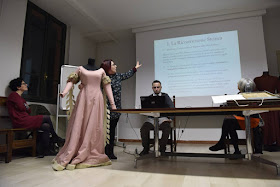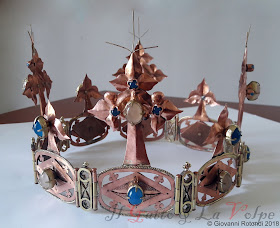 Elina è una rievocatrice esperta, attiva nell’ambito della rievocazione medievale in Finlandia dal 1995, autrice dal 2007 del blog “Neulakko” e membro dei Merry Swan: è uno dei miei miti indiscussi a partire dal giorno in cui mi sono accorta di amare il XIV secolo. Gli articoli sul suo blog, in particolare quelli sui veli, sono sempre stati un punto di riferimento, così come i suoi abiti e il loro accostamento con gli accessori giusti sono fonte di ispirazione. Recentemente, alla conferenza dedicata alla ricostruzione storica “Reconference 2018” (i video sono disponibili qui) Elina ha moderato una tavola rotonda sul tema dell’autenticità e dell’estetica: mi è sembrata quindi una buona occasione per chiederle di condividere alcune riflessioni su questi temi. Grazie mille Elina per la disponibilità!
Elina è una rievocatrice esperta, attiva nell’ambito della rievocazione medievale in Finlandia dal 1995, autrice dal 2007 del blog “Neulakko” e membro dei Merry Swan: è uno dei miei miti indiscussi a partire dal giorno in cui mi sono accorta di amare il XIV secolo. Gli articoli sul suo blog, in particolare quelli sui veli, sono sempre stati un punto di riferimento, così come i suoi abiti e il loro accostamento con gli accessori giusti sono fonte di ispirazione. Recentemente, alla conferenza dedicata alla ricostruzione storica “Reconference 2018” (i video sono disponibili qui) Elina ha moderato una tavola rotonda sul tema dell’autenticità e dell’estetica: mi è sembrata quindi una buona occasione per chiederle di condividere alcune riflessioni su questi temi. Grazie mille Elina per la disponibilità!Elina is an experienced re-enactor, active in the medieval scene in Finland since 1995, author of the blog “Neulakko” since 2007 and member of the group Merry Swan: she’s been one of my idols since the day I realized I was in love with 14th century. Her articles, especially the ones about veils, have always been a point of reference, just as her dresses and their combination with the right accessories are an endless source of inspiration. Recently, during the “Reconference 2018” (a conference about re-enactment, you can see the videos here), Elina moderated a panel about authenticity and aesthetics: it seemed to me a good chance to ask her to share a few thoughts about this subject. Thank you so much Elina![ENGLISH FOLLOWS]
Elina, cosa significa per te “avere un’estetica medievale”?
È una parte rilevante nel mio tentativo di proporre una rappresentazione il più autentica possibile. Per me l’autenticità è importante per rendere giustizia alle persone del passato che rappresentiamo: dobbiamo farlo raccontando una storia che sia bilanciata, basata sulle fonti e soltanto su quello, la storia di persone che hanno vissuto in un tempo e in una società differenti, con credenze e mezzi di sostentamento molto diversi da quelli di oggi, ma di persone che erano comunque esseri umani con speranze, paure, amore e dolore proprio come noi.
Perché è così difficile per noi persone moderne accettare di avere un aspetto diverso durante le rievocazioni? E perché invece dovremmo non solo accettare, ma abbracciare una diversa estetica?
Credo sia perché il gusto estetico è radicato talmente tanto in profondità nella nostra cultura e in noi stessi che diventa per noi quasi invisibile. È facile pensare che quello che è bello per me, ora, sia qualcosa di universalmente bello! Ma abbandonare il gusto estetico moderno e seguire quello medievale può essere molto gratificante: spesso è proprio quello che serve per fare rimanere senza fiato le persone e sentirle esclamare “sembra che tu sia appena uscito da un manoscritto!”
Qual è per te la rinuncia più difficile? C’è qualcosa del tuo aspetto quotidiano che ti manca quando sei in abiti medievali?
Questa è facile: il trucco moderno! Mille volte! Non truccarmi è davvero difficile per me, perché adoro il make up e tutto quello che lo riguarda. Quindi, “nel medioevo” mi manca avere le sopracciglia, lunghe ciglia e la pelle perfetta. Ma in ogni caso, ormai sono così abituata a non truccarmi in rievocazione che ora mi sembra veramente strano e sbagliato quando, qualche volta, mi trovo a casa a fare esperimenti su come indossare il velo con un trucco completo.
Invece, cosa ti piacerebbe introdurre nella tua quotidianità dal XIV secolo? C’è qualcosa che hai già adottato?
Indossare il velo significa che non c’è mai una giornata in cui i capelli non siano a posto e amo il comfort e la libertà di movimento che le gonne ampie forniscono, ma non ho introdotto nessuno dei due nella mia vita quotidiana! Comunque, i miei amici non -lhistorist (che non si occupano di living history, NdR) hanno commentato che sono una specie di maestra nella stratificazione dei vestiti, e credo di aver acquisito questa abilità grazie alla moda medievale.
Secondo te, quali sono le principali differenze tra l’estetica moderna e quella medievale?
Ci sono moltissimi aspetti, come la differente percezione di bellezza e decoro. Ma credo che le differenze più profonde e interessanti siano legate alle manifestazioni di genere, all’identificazione di cosa è femminile e cosa è maschile. Ci sono enormi differenze riguardo a quali parti del corpo devono essere nascoste e quali mostrate. Per esempio, conosco molti uomini che si trovano in difficoltà con lo stile medievale che prevede abiti aderenti ai fianchi e calzabraghe, perché il concetto moderno di mascolinità non riguarda esattamente l’esibizione delle proprie cosce sottili... Per le donne invece credo sia difficile entrare nell’ottica di un differente concetto di coprirsi, perché veniamo da un mondo con un concetto di “decoro” molto diverso.
Secondo la tua opinione, quali sono i punti chiave per una donna per ottenere un’estetica del XIV secolo convincente?
La chiave è la silhouette: la forma dei vestiti dovrebbe ricalcare l’aspetto di quelli medievali, e il modo migliore per ottenerlo è tagliare gli abiti sulla base dei modelli medievali, senza dimenticare l’uso di copricapi appropriati!
E per gli uomini?
Braghe, calzabraghe e vestiti che siano ben modellati addosso, ad esempio non troppo larghi. E il suggerimento di un copricapo adatto è valido anche per loro!
Qual è il tuo migliore consiglio per ottenere un look convincente?
Dedica del tempo ad osservare l’arte medievale per assorbire il gusto estetico, guardando sculture, dipinti, miniature così come gli oggetti. Poi: guarda il tuo equipaggiamento e confrontalo con quello che hai imparato. Chiediti: chi avrebbe indossato o utilizzato questo oggetto? Generalmente questo processo porta a una semplificazione dell’equipaggiamento: meno decorazioni, meno COSE (questo è il mio suggerimento preferito, perché non costa niente!).
***

| ||
It’s an important part in my attempt at doing a portrayal as authentically as possible. And authenticity is important to me because I believe that it is something we owe to the people of the past that we portray: to tell a story that is balanced, evidence based and just. A tale of people in a different time and society with very different beliefs and means of survival than today. But of people that were human with hopes and fears and love and sorrow just like us.
Why is it so difficult for us modern people to accept a different look during events? Why should we all embrace it instead?
I think it’s because aesthetics are set so deep in our culture and ourselves that they become almost invisible to us. It’s easy to think that what is beautiful to me now as something universal! But letting go of modern aesthetics and following the medieval look can be very gratifying: usually it’s doing just that that makes people gasp and say ”you look like you just stepped out of a manuscript”!
What’s the hardest thing for you? Do you miss anything of your everyday look when you are in medieval clothes?
This one is easy! Makeup! Times a hundred! Not wearing makeup is really hard for me because I love makeup and everything about it. So, in the middle ages I miss having eyebrows, long lashes and perfect skin. But then again - I’m so used to not wearing makeup by now that it looks really strange and wrong to me when I sometimes practice veil styles at home in full makeup.
On the other hand, what would you like to introduce in your everyday life from 14th century? Or is there something that’s already part of your daily life?
 |
| Elina e suo figlio: anche i bambini possono essere perfetti rievocatori! /Elina and her son: children can be super authentic re-enactors too! |
In your opinion, which are the main differences between modern aesthetics and medieval aesthetics?
There are so many things, like different perceptions of beauty and modesty. But I think the most profound and interesting differences are in the displays of gender: what is feminine and what is masculine. There are big differences in which parts of the body are to be hidden, what should be displayed. For an example, I know a lot of men struggle with the hip hugging styles and the hose, because modern masculinity is not so much about flaunting your slim thighs. For women the need to cover up is difficult, because we come from a world with very different standards of modesty.
According to you, which are the key points for a woman to get a good 14th century aesthetic?
It’s all in the silhouette: the fit of the clothes should follow the medieval look - the easiest way is to use medieval patterns. Also wearing a proper headcovering!
And for a man?
Hose and braies and a dress that is well fitting, i.e not too loose. And wearing headgear goes for men too!
What is your best advice to obtain a convincing look?
Spend time looking at medieval art to absorb the aesthetic: mix looking at sculpture, paintings, miniatures as well as items. then: take a look at your kit and compare it with what you have learned. Ask yourself: who would have worn/used this? Usually this results in simplifying your kit: less embellishment, less THINGS. (This is my favourite tip because it doesn’t cost anything!)
 |
| Elina con i Merry Swan al Middelaldercentret in Danimarca. / Elina with the Merry Swan at Middelaldercentret in Denmark. |


































